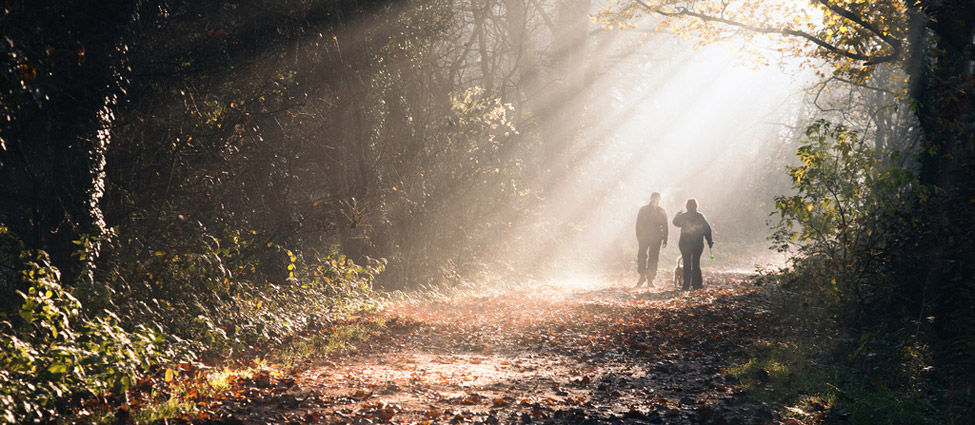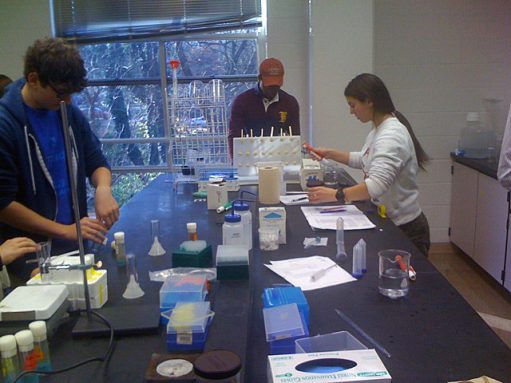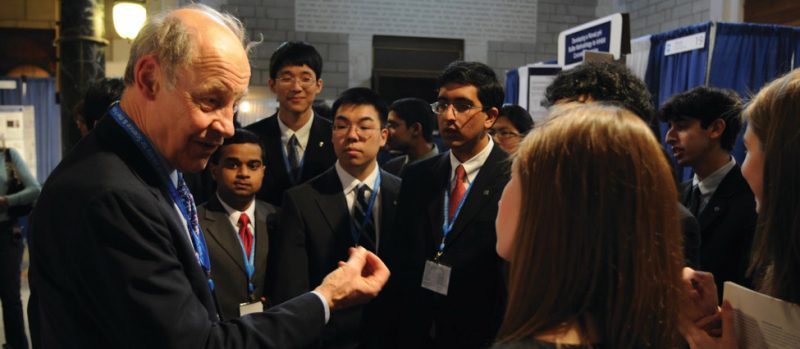How creativity powers science
Some of the best ideas come not from poring over the facts but from a walk in the woods

Going for a walk in the woods may lead to an aha! moment. Many people figure out creative, new ways to solve problems by allowing their minds to wander.
Gavin Clarke
Ask most people to identify a creative person, and they’ll probably describe an artist — Picasso, Shakespeare or even Lady Gaga.
But what about a Nobel prize–winning chemist? Or a team of engineers that figures out how to make a car engine operate more efficiently?
Creativity, it turns out, is not only the domain of painters, singers and playwrights, says Robert DeHaan, a retired Emory University cell biologist who now studies how to teach creative thinking.
“Creativity is the creation of an idea or object that is both novel and useful,” he explains. “Creativity is a new idea that has value in solving a problem, or an object that is new or useful.”
That can mean composing a piece of music that’s pleasing to the ear or painting a mural on a city street for pedestrians to admire. Or, DeHaan says, it can mean dreaming up a solution to a challenge encountered in the lab.
“If you’re doing an experiment on cells, and you want to find out why those cells keep dying, you have a problem,” he says. “It really takes a level of creative thought to solve that problem.”
But creative thinking, DeHaan and others say, isn’t always the focus of teaching in science classrooms.
“A lot of kids think that science is a body of knowledge, a collection of facts they need to memorize,” says Bill Wallace, a science teacher at Georgetown Day School in Washington, D.C.

That approach to learning about science, however, emphasizes only facts and concepts. It leaves little room for the creative thinking central to science, Wallace says.
“If instead, you teach science as a process of learning, of observing and of gathering information about the way that nature works, then there’s more room for incorporating creativity,” Wallace says.
“Science and math fairs — those develop a child’s sense of curiosity to dig in and figure out why things happen,” says Dave Incao, Vice-President of Global Walmart Support for Elmer’s Products. “Even if you don’t grow up to be an astronaut or mathematician, that sense of curiosity will help you in whatever career you pursue.”
And the approach to a scientific question and its analysis provide additional avenues for creativity.
“In the best science investigations, it’s not the questions that are most creative, but rather how the experiment is measured and how the data are interpreted, given meaning and how students see the investigation as a component in understanding a scientific problem,” says Carmen Andrews, a science specialist at Thurgood Marshall Middle School in Bridgeport, Conn.
Science as a creative quest
Indeed, scientists themselves describe science not as a set of facts and vocabulary to memorize or a lab report with one “right” answer, but as an ongoing journey, a quest for knowledge about the natural world.
“In science, you actually aren’t concerned right off the bat about getting the right answer — nobody knows what it is,” explains chemist Dudley Herschbach of Harvard University and a longtime leader of the board of trustees of Society for Science & the Public, publisher of Science News for Kids. “You’re exploring a question we don’t have answers to. That’s the challenge, the adventure in it.”

In the quest to make sense of the natural world, scientists think of new ways to approach problems, figure out how to collect meaningful data and explore what those data could mean, explains Deborah Smith, an education professor at Penn State University in State College, Penn.
In other words, they develop ideas that are both new and useful — the very definition of creativity.
“The invention from the data of a possible explanation is the height of what scientists do,” she says. “The creativity is about imagining possibility and figuring out which one of these scenarios could be possible, and how would I find out?”
Unfocusing the mind
Imagining possibilities requires people to use what scientists who study how the brain works call “associative thinking.” This is a process in which the mind is free to wander, making possible connections between unrelated ideas.
The process runs counter to what most people would expect to do when tackling a challenge. Most would probably think the best way to solve a problem would be to focus on it — to think analytically — and then to keep reworking the problem.
In fact, the opposite approach is better, DeHaan argues. “The best time to come to a solution to a complex, high-level problem is to go for a hike in the woods or do something totally unrelated and let you mind wander,” he explains.
When scientists allow their minds to roam and reach beyond their immediate research fields, they often stumble onto their most creative insights — that “aha” moment, when suddenly a new idea or solution to a problem presents itself.
Herschbach, for example, made an important discovery in chemistry shortly after he learned of a technique in physics called molecular beams. This technique allows researchers to study the motion of molecules in a vacuum, an environment free of the gas molecules that make up air.
Physicists had been using the technique for decades, but Herschbach, a chemist, hadn’t heard of it before — nor had he been told what couldn’t be done with crossed molecular beams. He reasoned that by crossing two beams of different molecules, he might learn more about how quickly reactions occur as molecules collide with one another.
Initially, Herschbach says, “People thought it would not be feasible. It was called the lunatic fringe of chemistry, which I just loved.” He ignored his critics, and set out to see what would happen if he crossed a beam of molecules such as chlorine with a beam of hydrogen atoms.
He spent several years collecting his data, which in the end uncovered new insights into the ways colliding molecules behave. It was an important enough advance in chemistry that in 1986 Herschbach and a colleague were awarded science’s top honor: the Nobel Prize.
In hindsight, he says, “It seemed so simple and obvious. I don’t think it took a lot of insight as much as naïveté.”
Fresh perspectives, new insights
Herschbach makes an important point. Naïveté — a lack of experience, knowledge or training — can actually be a boon to finding creative insights, DeHaan says. When you’re new to a scientific field, he explains, you’re less likely to have learned what other people claim is impossible. So you come to the field fresh, without any expectations, sometimes called preconceptions.
“Preconceptions are the bane of creativity,” DeHaan explains. “They cause you to immediately jump to a solution, because you’re in a mode of thinking where you’ll only see those associations that are obvious.”
“Preconceived notions or a linear approach to solving problems just puts you in this tight little box,” adds Susan Singer, a professor of the natural sciences at Carleton College in Northfield, Minn. Often, she says, “It’s in allowing the mind to wander when you find the answer.”
The good news: “Everyone has the aptitude for creative thinking,” says DeHaan. You just need to broaden your thinking in ways that allow your mind to connect ideas that you might not have thought were related. “A creative insight is just allowing your memory to pick up on ideas you never thought about before as being in the same context.”
Creativity in the classroom
In the classroom, broadening your thinking can mean emphasizing something called problem-based learning. In this approach, a teacher presents a problem or question with no clear or obvious solution. Students are then asked to think broadly about how to solve it.
Problem-based learning can help students think like scientists, Wallace says. He cites an example from his own classroom. Last fall, he had students read about fruit flies that lack an enzyme — a molecule that speeds up chemical reactions — to break down alcohol.
He asked his students to find out whether these flies would feel the effects of alcohol, or even become inebriated, sooner than would flies that possess the enzyme.
“I had seven groups of students, and got seven different ways to measure inebriation,” he says. “That’s what I would call creativity in a science class.”
“Creativity means taking risks and not being afraid to make mistakes,” adds Andrews. In fact, she and many educators agree, when something comes out differently than expected, it provides a learning experience. A good scientist would ask “Why?” she says, and “What’s happening here?”
Talking with others and teamwork also help with associative thinking — allowing thoughts to wander and freely associating one thing with another — that DeHaan says contributes to creativity. Working on a team, he says, introduces a concept called distributed reasoning. Sometimes called brainstorming, this type of reasoning is spread out and conducted by a group of people.
“It’s been known or thought for a long time that teams generally are more creative than individuals,” DeHaan explains. While researchers who study creativity don’t yet know how to explain this, DeHaan says it could be that by hearing different ideas from different people, members of a team begin to see new connections between concepts that didn’t initially seem related.
Asking questions such as, “Is there some way to pose the problem other than the way it was presented?” and “What are the parts of this problem?” also can help students stay in this brainstorming mode, he says.
Smith cautions against confusing artistic or visual representations of science with scientific creativity.
“When you talk about creativity in science, it’s not about, have you done a nice drawing to explain something,” she says. “It’s about, ‘What are we imagining together? What’s possible, and how could we figure that out?’ That’s what scientists do all the time.”
Although using arts and crafts to represent ideas can be helpful, Smith says, it is not the same as recognizing the creativity inherent in science. “What we’ve been missing is that science itself is creative,” she explains.
“It’s a creativity of ideas and representations and finding things out, which is different from making a papier-mâché globe and painting it to represent the Earth,” she says.
In the end, educators and scientists agree that anyone can learn how to think like a scientist. “Too often in school, students get the impression that science is for a specially gifted subspecies of humanity,” Herschbach says. But he insists just the opposite is true.
“Scientists don’t have to be so smart,” he continues. “It’s all there waiting for you if you work hard at it, and then you have a good chance of contributing to this great adventure of our species and understanding more about the world we live in.”
Power words
(Adapted from the American Heritage Children’s Science Dictionary)
Enzyme: a molecule that helps start or speed up chemical reactions
Molecule: a group of two or more atoms joined together by sharing electrons in a chemical bond